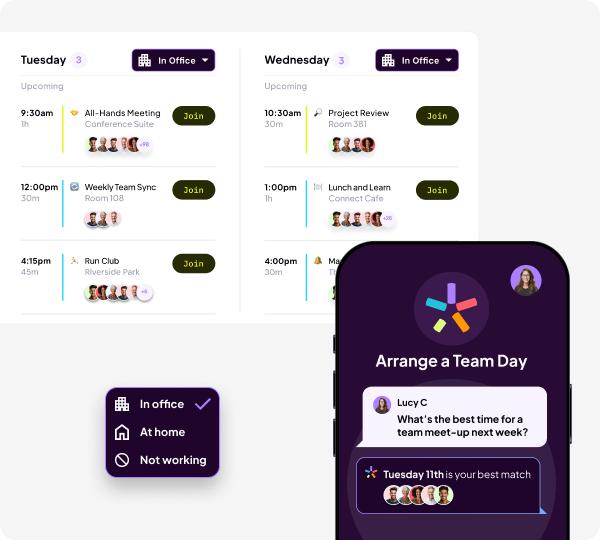15 min read 29 October 2025
A Complete Guide to Hybrid Work: Best Practices, Strategies, Tactics and Technology for 2026
In this guide we'll cover what hybrid work actually means, why it's still so polarizing, benefits, challenges, how to choose the right schedule, how to create a hybrid work strategy and more.
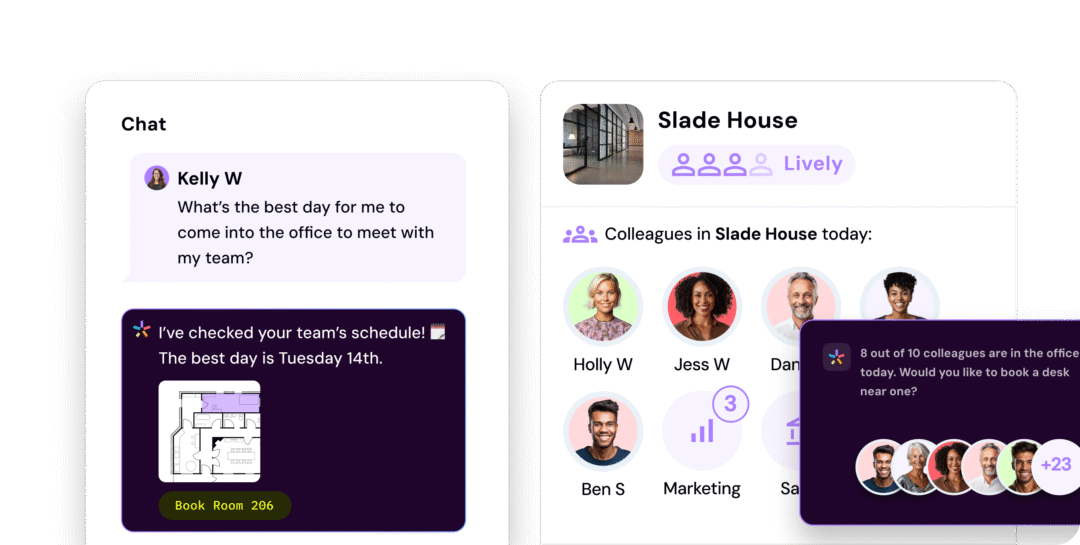
Why is Hybrid Work Still So Contentious?
Most of us probably predicted that hybrid work would be yesterday’s news by now. Since virtually everyone who works at a desk uses some form of it, you might have thought hybrid work would just be considered work.
But here we are in (almost) 2026, and hybrid work remains both the default work model and the most hotly debated topic in workplace strategy. Instead of becoming normalized, hybrid has created distinct camps: staunch advocates, fierce opponents, and every shade of opinion in between on how it should be implemented.
So going on six years after the pandemic initially forced this shift, let’s take a comprehensive look at hybrid work. Whether you’re a workplace leader trying to optimize your strategy or dealing with a policy crisis, this guide covers everything you need to know:
Hybrid work topics
Click on one of the 6 hybrid work topics below for more.
How do you make hybrid a success?
How to solve the most common hybrid work challenges
A guide for hybrid organizations
Why it's critical to define your workplace experience and tips to improve it
What do you do if you pick the wrong hybrid work schedule?
Signs that your organization is in a hybrid policy crisis and how to fix it.
Hybrid workplace design best practices for 2026
4 tips for improving your hybrid office using workplace data
3 things damaging connection and collaboration in your hybrid office
Remote work doesn't actually make people less connected. Here's what does, and how to fix it
5 office space utilization metrics for a better hybrid workplace
Start measuring these 5 metrics to understand how your hybrid workplace is supporting employees and business objectives
Hybrid Work: A Definition
Hybrid work is a work model where employees split their time between working remotely and working in the office.
For most organizations, hybrid work means a weekly schedule with a pre-defined number of office days and remote days. But technically, someone working one day per month in the office is still hybrid working. So while the organization defines the parameters of hybrid work, culturally, it means at least a couple days in the office.
Although the term exploded during the pandemic, hybrid work isn’t new. The first hybrid work pilot was actually designed by a rocket scientist named Jack Nilles back in the 1970s. Even without the internet, participants saw turnover plummet, productivity skyrocket, and expenses get slashed.
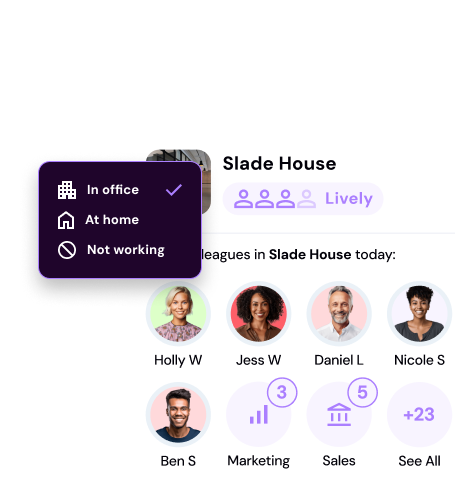
What is Workplace Experience? A Guide for Hybrid Workplaces
Workplace experience is more than just an HR buzzword. Here’s what it actually means and what hybrid organizations can do to improve it.

Hybrid Work Benefits and Challenges
Let’s look at what the data actually says about the benefits and challenges of hybrid work.
Benefits
1. Improved wellbeing and workplace experience
71% of employees surveyed by Gallup list a better work-life balance as hybrid work’s top advantage. The ripple effects are improved productivity, easier hiring, reduced churn rate and better wellbing. By accommodating family and life commitments, hybrid roles broaden the available talent pool.
2. Improved organizational performance
Companies with flexible work policies are significantly more profitable than restrictive peers. Organizations giving employees location choice had 16 percentage points better revenue growth, according to recent Flex Index research. This could stem from the 51% of employees who report better productivity with hybrid work, or from creating a results-driven culture that attracts top talent and enables faster scaling.
3. Reduced real estate costs
Real estate is most organizations’ second-biggest expense after salaries. 81% of CFOs report that hybrid work is saving money through portfolio downsizing and shared office arrangements.
Case Study: How a Fortune 500 Company Reduced Their CRE Portfolio by 40% with HubStar
Read more about how this Fortune500 company slashed their CRE portfolio square footage by 40%, saving millions.

Challenges
1. Workplace experience depends on occupancy
Microsoft found that collaboration between groups decreased by 25% after adopting remote work company-wide, while 55% of hybrid employees reported increased loneliness. However, many find traditional “watercooler moments” and office small talk distracting and superficial rather than valuable.
2. Understanding actual workplace patterns and preferences isn’t easy
Specifically in the case of stricter hybrid work schedules like specific days, employee preferences become more difficult to measure since policy overrides choice. This makes it difficult to design the workplace around how people are actually working, leading to a costly mismatch when policy adherence drops off.
3. Uneven utilization rates over the week
Uneven utilization creates overcrowded offices on popular days, leading to a poor workplace experience while leaving expensive real estate sitting empty on emptier days. The operating costs and emissions required to keep empty spaces ticking along at full speed really add up over time.
Top 3 Hybrid Work Challenges and How to Solve Them
Even positive changes create challenges. Here are 3 hybrid work challenges your organization is most likely to run into and how to fix them.

4 Types of Hybrid Work Schedules
This is where things get really contentious, especially when mandatory office policies enter the picture. The data shows that rigid mandates reduce revenue growth, erode leadership trust, and damage retention, but different schedules work for different organizations.
Here are four hybrid schedules you’ll see most organizations go for, what they’re best for and the risks of each approach.
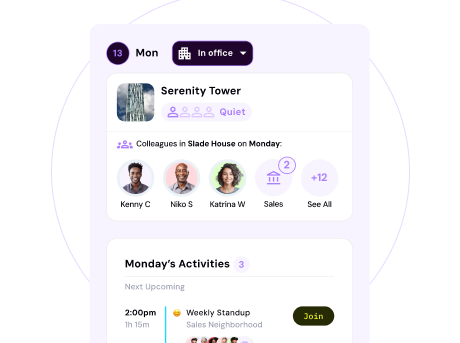
1. Trust-based hybrid
What it is: Employees choose when and how often to come into the office
Best for: High-trust cultures with strong results orientation
Risk: Potential for empty offices or coordination challenges
2. Specific-days hybrid
What it is: Employees must be in office on designated days (e.g., Tuesdays and Thursdays)
Best for: Teams needing predictable face-time for collaboration
Risk: Overcrowding and poor workplace experience Tuesdays through Thursdays
3. Minimum days hybrid
What it is: Employees must be in office a certain number of days per week/month but choose which days
Best for: Most hybrid organizations (42% use this model as of Q3 2025)
Risk: Coordination challenges and uneven utilization
4. Team-level agreements
What it is: Each team or department decides their own office schedule
Best for: Organizations with diverse role requirements
Risk: Potential inequity between teams and complex management
Failed Hybrid Policy Guide: From Crisis to Competitive Advantage
If your organization’s hybrid work policy fails, can you fix it? Yes. In this guide, you’ll learn how, plus the signs to look out for.

Step 1: Shape your vision and set objectives
Change is easier when everyone knows where you’re going and why. Without a clear vision, your hybrid strategy becomes rudderless, and leaders can’t make aligned decisions.
Key questions:
- What does successful hybrid work look like for your organization?
- Are you aiming to right-size your portfolio, build better culture, boost productivity, or all three?
Guide For Workplace Innovators Leading Dynamic Workplace Change
A practical guide for workplace leaders with 10 human-centered principles to lead lasting change in today’s fast-moving hybrid world.
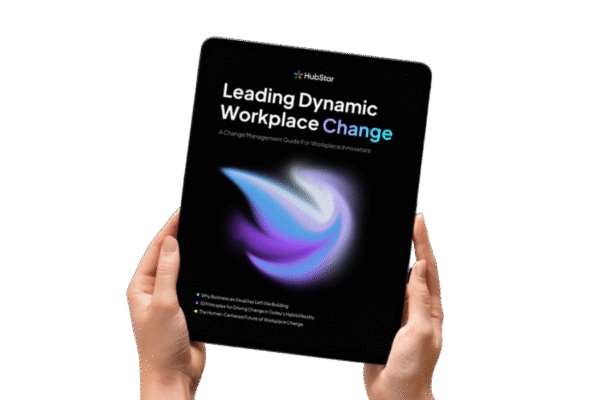
Step 2: Measure workplace patterns and preferences
You can’t plan for the future without understanding your current reality. Most organizations base strategies on assumptions rather than actual data—a critical mistake.
Essential data points:
- Space utilization rates by day, week, and space type
- Employee preferences for office vs. remote work
- Peak usage patterns and bottlenecks
- Which amenities and spaces get the most use
5 Office Space Utilization Metrics for a Better Hybrid Workplace in 2026
How do you measure whether hybrid work is actually working? Office space utilization metrics are a solid place to start. Here are 5 to start tracking.

Step 3: Design your hybrid schedules and policies
Use insights from your data to create realistic policies that work for both employees and your physical workplace. Consider company culture, existing workflows, and change management capacity.
Remember: 26% of employees would rather have a root canal than return to the office five days a week. Design accordingly, working in space for quiet individual work and informal collaboration spaces where people can connect.
3 Things Destroying Social Connection in Your Hybrid Workplace
Contrary to popular belief, hybrid and remote work don’t damage workplace social connection. Here are 3 things that do.

Step 4: Optimize your spaces and technology
A Cisco study found over 50% of office space is still dedicated to individual work, despite “meeting with colleagues” being the top reason people come to the office. Most spaces need significant reconfiguration for hybrid success.
Technology considerations:
- Room and desk booking systems to prevent arrival disappointments
- Collaboration tools that work seamlessly across locations
- Analytics platforms to track utilization and inform decisions
Think Desk Booking is About Booking Desks? Think Again.
Desk booking actually goes way further than merely nabbing your favorite desk Tuesday through Thursday. Here’s why.

Step 5: Measure and iterate
Executive a hybrid work strategy is never finished. External events, changing employee preferences and evolving business needs require continuous adaptation.
Create feedback loops for:
- Employee satisfaction with hybrid arrangements
- Space utilization efficiency
- Collaboration effectiveness
- Business outcome metrics
How do you get the right data for hybrid office design?
Download this practical toolkit the 5 core workplace metrics that provide the right data for effective hybrid office design.
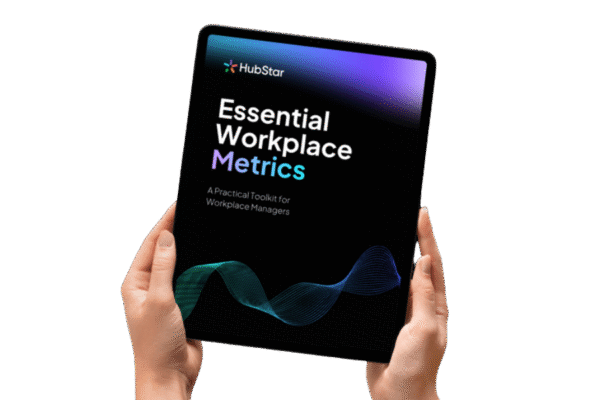
Tactics and Tech to Make Hybrid Work in 2026
Tech helps to execute your organization’s mission and vision for how and where people should work, but it’s not a replacement. Once that’s in place, tech can make the difference between chaos and comfort in the office.
Stakeholder alignment:
- Processes to align HR, IT, CRE, Ops, Workplace Experience and the C-Suite
- Clearly outlined responsibilities of who’s responsible for which parts of the hybrid workplace
- Straightforward ways to share data for workplace procedures like departmental space allocation
Workplace occupancy data:
- Data that covers large and small spaces
- Predictive space usage insights for space planning and policy optimization
- Utilization reporting that informs real estate and design decisions
4 Data-Driven Hybrid Office Design Tips for 2026
Hybrid office design can make or break everything from attendance levels to retention. With so many design options, what’s the right way to do it?

Hybrid space Management:
- Desk and room booking systems that integrate with existing floorplans
- Real-time occupancy tracking to understand actual usage patterns
- Flexible space configurations that adapt to daily demand fluctuations
Workplace Experience Tools:
- Team coordination tools to align hybrid schedules
- Office event promotion to drive purposeful attendance
- Extensive choice of working environments (e.g. individual office pods, cafes)
Key Takeaways
- Hybrid success depends on how schedules, policies, expectations and overall strategy are created
- Hybrid work improves retention and boosts cost savings, but creating spaces for effective collaboration still needs work
- Choose a hybrid schedule based on your culture and organizational objectives, not what everyone else is doing
- Build a hybrid work strategy with distinctive steps but iterate continuously
- The right systems and tech prevent chaos
Get actionable tips for hybrid strategies and workplaces in these guides:
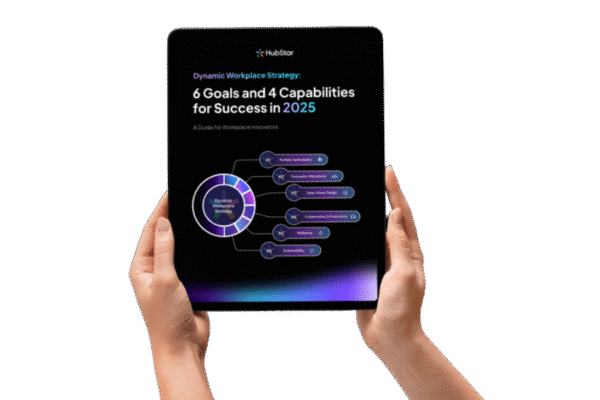


HubStar can help you build, manage and improve your hybrid workplace.
Check out our blog and guides for practical steps and insights to make hybrid work.
Share this post
